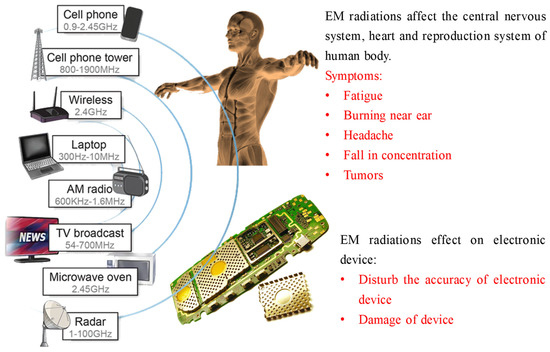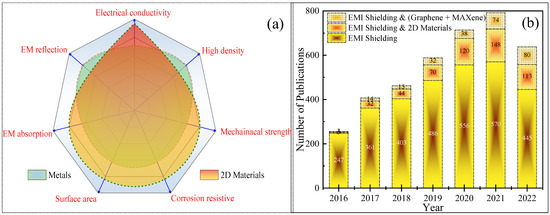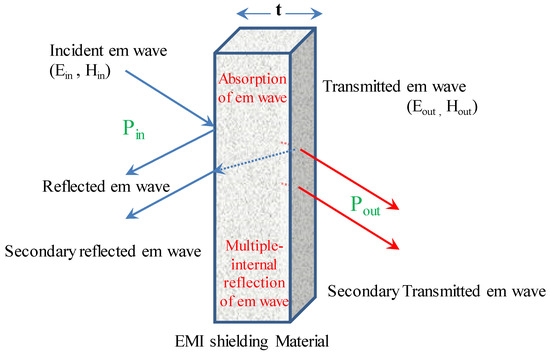Graphene is the first two-dimensional material that becomes the center material in various research areas of material science, chemistry, condensed matter, and engineering due to its advantageous properties, including larger specific area, lower density, outstanding electrical conductivity, and ease of processability. These properties attracted the attention of material researchers resulted in a large number of publications on EMI shielding in a short time and play a central role in addressing the problems and challenges faced in this modern era of electronics by electromagnetic interference. After the popularity of graphene, the community of material researchers investigated other two-dimensional materials like MXenes, hexagonal boron nitride, black phosphorous, transition metal dichalcogenides, and layered double hydroxides, to additionally enhance the EMI shielding response of materials.
- EMI shielding
- shielding mechanism
- two-dimensional materials
- graphene
- Microwave absorption
- Mxene
1. Introduction


2. EMI Shielding
Through the use of a barrier made of particular materials, EMI shielding safeguards the system from electromagnetic radiation. The barrier is performing reflection, absorption, or a combined effect of both while the electromagnetic waves are incident on it. In EMI, wresearchers consider two regions of shielding: the near-field and the far-field shielding regions. It is thought to be in the far-field shielding region when the distance between the shield and the incident electromagnetic source is larger than λ/2, where λ is the wavelength of the EM wave, and in the near-field shielding region otherwise. The participation of both electric and magnetic dipoles is implemented in the near-field portions of EMI shielding, whereas the EM plane wave theory is employed in the far-field shielding zones [5]. An abstract representation of how electromagnetic waves and a shield interact is depicted in Figure 3. The incidence of electromagnetic waves on the shield causes multiple internal reflections, reflection and absorption of waves. Electromagnetic component which is neither reflected nor absorbed is residual radiation in EMI, which emerges from the shield [6].
2.1. Concept of Green EMI Shielding
EMI shielding can be provided through two ways: via reflection and/or absorbing the EM radiations. The shielding due to reflection has caused one big problem because, in this phenomenon, the shield also acts as a secondary source of EM radiations. Moreover, the reflected radiations can further be free to interact with electronics devices and living bodies. As results, the chance of EM interference and other damaging effects still remains alive. Thus, the shielding due to absorption phenomena is appreciated over the reflection phenomena. Concerning the facts, Cao et al. group introduced the concept of green EMI shielding index (gs) [7,8,9][7][8][9]. The term gs (=1/|S211|−|S221|/|S211|−1, where S11 and S12 are scattering parameters) determines the eco-friendly nature of shielding material which not only shows efficient shielding results but also controls the secondary emission of EM radiations. gs > 1 represents the less secondary emission of EM radiations and significant contribution of absorption phenomena in the shielding. Foremost, Wang et al. focused on eco-friendly shielding material and synthesized the 3D eco-mimetic nanostructure of PEDOT/Fe3O4/graphene with gs of 1.44 [7]. Zhang et al. prepared the WS2/rGO architecture that exhibits effective a green shielding effectiveness index of value > 1 [10].2.2. Shielding Effectiveness
The ratio of the incident wave’s field strength to the transmitted wave’s field strength is known as the shielding efficacy and can be formulated as: P is the strength of the plane wave; the subscript in indicates the incident wave and out indicates the transmitted wave.
A shielding material’s efficacy in blocking radiation serves as a measure of its performance (SE). Decibels are used to assess the attenuation caused by internal reflection, absorption, and other phenomena (dB). Thus, the overall shielding efficacy of a shielding substance (SET) comprises SEs contributions from reflection (SER), absorption (SEA), and multiple-reflections (SEM) and written as:
P is the strength of the plane wave; the subscript in indicates the incident wave and out indicates the transmitted wave.
A shielding material’s efficacy in blocking radiation serves as a measure of its performance (SE). Decibels are used to assess the attenuation caused by internal reflection, absorption, and other phenomena (dB). Thus, the overall shielding efficacy of a shielding substance (SET) comprises SEs contributions from reflection (SER), absorption (SEA), and multiple-reflections (SEM) and written as:


Shielding Effectiveness Calculation
The scattering parameters S11, S12, S21, and S22 measured on a vector network analyzer (VNA) are used to calculate SE. The scattering parameters signify the strength of the reflected or transmitted signal with respect to the incident signal strength. VNA can transmit or receive as well as record the EM signal intensities over a wider frequency range. Coefficients of reflection (R), transmittance (T), and the absorption (A) for the EM signal are also calculated in terms of S-parameters as follows [13]:


2.3. Shielding Measurement
-
Open Field or Free Space Method;
-
Shielded Box Method;
-
Shielded Room Method;
-
Coaxial Transmission Line Method.
2.4. Factors Effecting EMI Shielding Performance


References
- Balmori, A. Anthropogenic radiofrequency electromagnetic fields as an emerging threat to wildlife orientation. Sci. Total Environ. 2015, 518–519, 58–60.
- Engels, S.; Schneider, N.L.; Lefeldt, N.; Hein, C.M.; Zapka, M.; Michalik, A.; Elbers, D.; Kittel, A.; Hore, P.J.; Mouritsen, H. Anthropogenic electromagnetic noise disrupts magnetic compass orientation in a migratory bird. Nature 2014, 509, 353–356.
- Hutchison, Z.L.; Gill, A.B.; Sigray, P.; He, H.; King, J.W. Anthropogenic electromagnetic fields (EMF) influence the behaviour of bottom-dwelling marine species. Sci. Rep. 2020, 10, 4219.
- Sienkiewicz, Z. Biological effects of electromagnetic fields. Power Eng. J. 1998, 12, 131–139.
- Yavuz, Ö.; Ram, M.K.; Aldissi, M. Electromagnetic applications of conducting and nanocomposite materials. In The New Frontiers of Organic and Composite Nanotechnology; Elsevier: Amsterdam, The Netherlands, 2008; pp. 435–475.
- Chung, D.D. Electromagnetic interference shielding effectiveness of carbon materials. Carbon 2001, 39, 279–285.
- Wang, X.; Shu, J.; Cao, W.; Zhang, M.; Yuan, J.; Cao, M. Eco-mimetic nanoarchitecture for green EMI shielding. Chem. Eng. J. 2019, 369, 1068–1077.
- Zhang, M.; Cao, M.; Shu, J.; Cao, W.; Li, L.; Yuan, J. Electromagnetic absorber converting radiation for multifunction. Mater. Sci. Eng. R 2021, 145, 100627.
- Cao, M.; Wang, X.; Zhang, M.; Cao, W.; Fang, X. Variable-Temperature Electron Transport and Dipole Polarization Turning Flexible Multifunctional Microsensor beyond Electrical and Optical Energy. Adv. Mater. 2020, 32, 1907156.
- Zhang, D.; Liu, T.; Shu, J.; Liang, S.; Wang, X.; Cheng, J.; Wang, H.; Cao, M. Self-Assembly Construction of WS2-rGO Architecture with Green EMI Shielding. ACS Appl. Mater. Interfaces 2019, 11, 26807–26816.
- Farukh, M.; Dalal, J.; Ohlan, A.; Singh, K.; Dhawan, S.K. Synthesis of Poly (3, 4-ethylene dioxythiophene) Conducting Polymer Composites for EMI Shielding Applications. Bentham Sci. 2022, 213–270.
- Dalal, J.; Gupta, A.; Lather, S.; Singh, K.; Dhawan, S.K.; Ohlan, A. Poly(3, 4-ethylene dioxythiophene) laminated reduced graphene oxide composites for effective electromagnetic interference shielding. J. Alloys Compd. 2016, 682, 52–60.
- Dalal, J.; Malik, S.; Dahiya, S.; Punia, R.; Singh, K.; Maan, A.S.; Dhawan, S.K.; Ohlan, A. One pot synthesis and electromagnetic interference shielding behavior of reduced graphene oxide nanocomposites decorated with Ni0.5Co0.5Fe2O4 nanoparticles. J. Alloys Compd. 2021, 887, 161472.
- Yang, Z.; Peng, H.; Wang, W.; Liu, T. Crystallization behavior of poly(ε-caprolactone)/layered double hydroxide nanocomposites. J. Appl. Polym. Sci. 2010, 116, 2658–2667.
- Kumari, S.; Dalal, J.; Kumar, A.; Ohlan, A. Microwave Absorption Performance of Core–Shell rGO/Ni0.5Co0.5Fe2O4@PEDOT Composite: An Effective Approach to Reduce Electromagnetic Wave Pollution. Adv. Eng. Mater. 2022, 24, 2200635.
- Cao, M.; Wang, X.; Cao, W.; Fang, X.; Wen, B.; Yuan, J. Thermally Driven Transport and Relaxation Switching Self-Powered Electromagnetic Energy Conversion. Small 2018, 14, 1800987.
- Wang, X.X.; Zhang, M.; Shu, J.C.; Wen, B.; Cao, W.Q.; Cao, M.S. Thermally-tailoring dielectric “genes” in graphene-based heterostructure to manipulate electromagnetic response. Carbon 2021, 184, 136–145.
